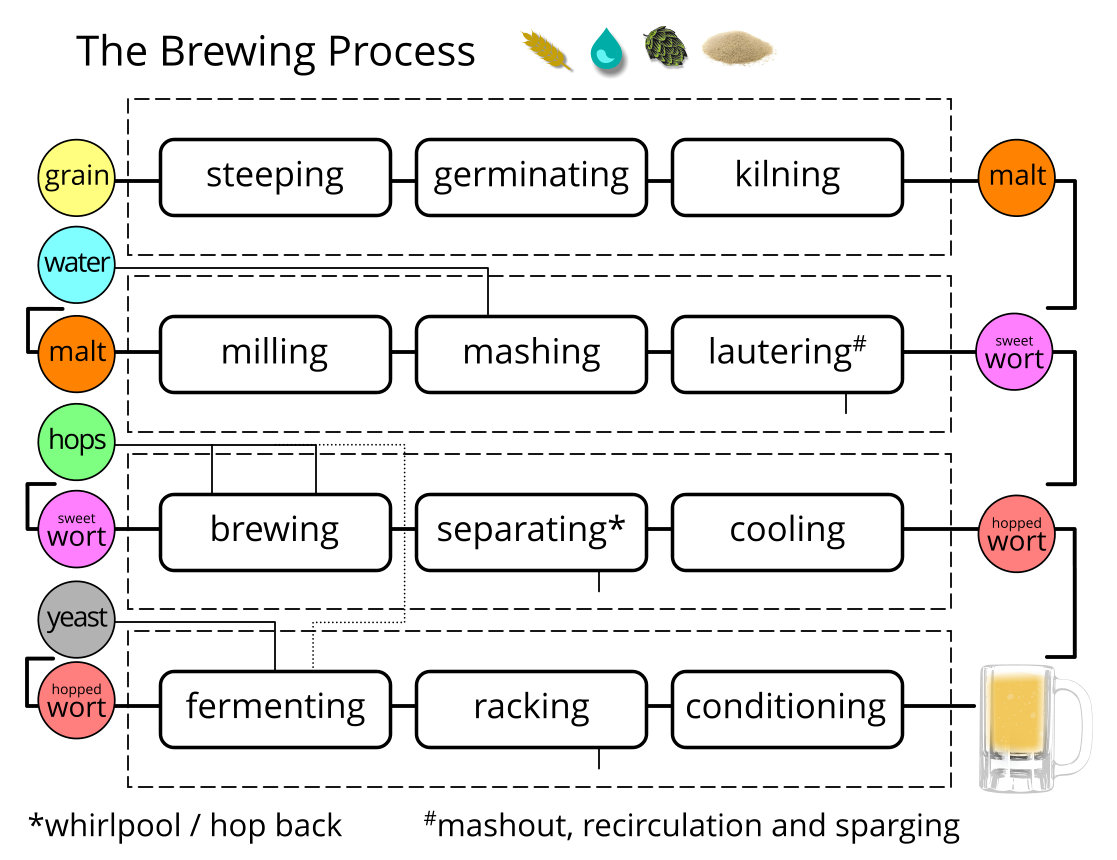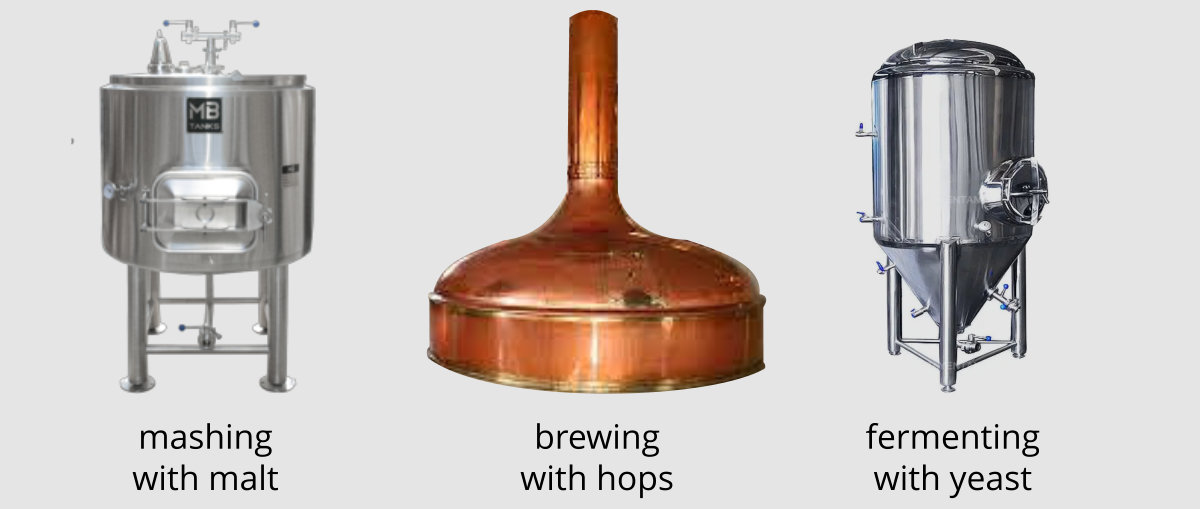Beer is the most consumed alcoholic drink worldwide.
It is traditionally made from four key ingredients: malted cereals (barley
or other), water, hops, and yeast. Each of these ingredients contributes to
the final taste and aroma of beer. The solids are removed by various methods.

Water
The amount of minerals in brewing water affects the beer in several ways.
• The pH (acidity) affects the efficiency of the brewing process (as does hardness) as well as how the beer flavours appear to your palate.
• sulphates will tend to give the beer a drier, more assertive hop balance,
while chlorides will tend to have a less bitter, rounder, and maltier balance.
• chlorine or contaminants can cause off-flavours
The overall recipe for the beer will take these into account; a consistent
quality of water thus being highly desirable.
Malt
Malt is really any type of grain that has gone through the malting process
to bring out sugars. The basic malting steps are steeping in water, resting
under precise conditions to encourage enzymes and germination, and kilning
(drying and curing). For many specialty malts, two other steps—stewing
and/or roasting, preferably both in a roasting drum—are used as well.
There are several different categories of malt: base malts, caramel/dextrin
malts, crystal malts, chocolate/roasted malts, and roasted raw grains. Base
malts are gently kilned and are usually pale and highly enzymatic. They account
for at least half the grist in most mashes. All other non-base malts are considered
“specialty malts.” These add varying degrees of colour, flavour,
aroma, and texture to the finished beer. There are over 1000 malts on offer.
Caramel malts require stewing. Chocolate malts are slightly stronger in colour
and aroma than caramel and crystal malts and are roasted. These later treatments
reduce the enzymes which convert the grains' starches into sugar.
The malt is then mixed with the water and milled, mashed and lautered
(separated from unwanted solids to create the wort, or mash). For the highest
level of efficiency, lautering has three phases: mashout, recirculation, and
sparging.
Hops
While not as significant for flavour and aroma as the malts, brewers use hops
in beer to varying degrees. In some styles, like the ubiquitous IPA, hops
take centre stage. In other styles, like stouts, they add backbone and depth.
There are many different kinds of hops available to brewers. And just like
wine grapes, hops of different strains and from different growing regions
bring different flavours, aromas, and bittering capabilities.
Noble hops, from Germany and the Czech Republic are considered the most classic.
They are what lend traditional German and Czech pilsners and lagers their
characteristic flavour profiles.
English hops (e. g. Fuggle) have lower levels of the oil myrcene, allowing
more subtle aromas of other essential oils to shine through. The profiles
of English hops, therefore, tend to be more delicate and milder, notes of
earth, molasses, herbs, spice, and wood.
American hops, (e.g. Cascade and Centennial) tend to have higher amounts of
the essential oil myrcene, which gives them their bold, highly aromatic characteristic
citrus and pine notes.
Hops are added at different stages of brewing to have different effects. Additional
hops may be added after the brewing and cooling process to add different aromas
while avoiding adding the bitterness that comes at higher temperature and
this is called dry hopping.
There are over 170 different varieties. See https://www.morebeer.com/articles/homebrew_beer_hops/
Hops are added to the wort, which is boiled and then the solids separated
out in a whirlpool
Yeast
Yeast is used in fermentation, acting on carbohydrates to create CO2 gas bubbles
and alcohol. Its contribution to the aromatic profiles of beers and wines
is often underestimated.
During the fermentation process, yeast modifies carbohydrates into a variety
of metabolic by-products. These compounds give fermented products distinctive
taste and flavour, but also texture.
The white foamy top on beer produced by yeast consists of carbon dioxide gas,
produced during the fermentation process, trapped into proteins that gather
around it creating bubbles. Proteins from the yeast contribute to the stabilization
of ale or lager’s foam, which keep the beer’s “head”
from dissipating quickly.
During fermentation, yeast cells convert cereal-derived sugars into ethanol
and CO2. At the same time, hundreds of secondary metabolites are produced
that influence the aroma and taste of beer. Variation in these metabolites
across different yeast strains is what allows yeast to so uniquely influence
beer flavour.
Two different species of yeasts relate to the two main families of beers:
lagers and ales. For lagers, Saccharomyces pastorianus is favoured. These
drop to the bottom while fermenting. It produces relatively few esters and
makes light and thirst-quenching beers, such as pilsners, although dark beers
are equally possible. For ales, Saccharomyces cerevisiae is favoured. These
rise to the top while fermenting. It produces beers that are more complex
and aromatic and that often have a higher alcohol content. Cerevisiae is also
used in bread and wine making.
The chilled wort is pumped into tanks for fermentation under strictly
controlled temperature. Brewer’s yeast turns the wort into alcohol and
carbon dioxide. The kind of yeasts used, and the fermentation temperature
will determine whether the final product is an ale or a lager beer.
Finally, the beer is chilled and allowed to settle. Filtration and period
of settlement depend on beer style. Not all beers go through filtering. Real
ales may be racked directly into the cask where secondary fermentation occurs.
Other ingredients
Traditionally, in Belgium, fruit is added to some beers to counteract sharpness.
This and other flavourings have become popular elsewhere with the craft beer
craze. Each to his own taste!
Before hops were used, a gruit was added to flavour and preserve the beer,
typically composed of bog myrtle, yarrow, and rosemary, but could also include
other botanicals such as heather, juniper, ginger, caraway, orange peel and
cinnamon.
